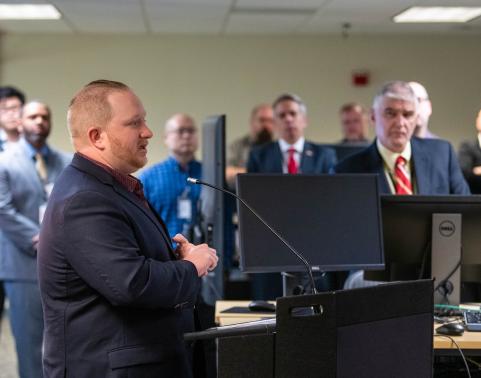Move to Software Acquisition Pathway, tighter team integration benefit GFIM

This past March, the Army Acquisition Executive officially signed off on the Global Force Information Management (GFIM) program’s move to the Software Acquisition Pathway (SWP). For the GFIM product office at Program Executive Office Enterprise Information Systems (PEO EIS), the program’s transition off the Defense Business Systems Acquisition Pathway makes Agile software development significantly easier.
Instead of focusing on the five key milestones and high-level approvals required to get through the DBS Pathway’s business capability acquisition cycle, the GFIM team can get right down to developing a solution for their Army customer.
“With the Software Acquisition Pathway, there’s planning and execution — it’s really that simple,” said Jessica Li, deputy product director for GFIM at PEO EIS.
For the GFIM product office, that means working closely with the vendor they selected in December 2023 to continue phase two of the Other Transaction Authority procurement to deliver minimum viable capability release by fall 2024. At that point, the GFIM program will enter the execution phase to provide production-ready capability.
While the GFIM acquisition team began using Agile before Rob Porter took over as product director in August 2023, the team has since become more intentional about implementing best practices and integrating more closely with partners.
“As we’ve gone through each planning interval (PI),” said Li, “we learn about how to become more efficient and integrate with functionals continuously in a better way.”
The mission of GFIM's functional sponsor, the Army’s G-3 Capabilities Management Office, is to modernize force management and promote data-informed decision-making by replacing 15 legacy systems within the GFIM Operational Environment by adding an artificial intelligence/analytics component.
At GFIM’s second PI event at PEO EIS headquarters in Fort Belvoir, Virginia in April 2024, G-3 Capabilities Management Officer Lori Mongold deemed the Agile meet-up the “most successful and productive engagement we’ve ever had.”
Part of this sentiment may be due to improved communications and tightened integration between the G-3 and EIS acquisition team.
“It all comes down to how we're communicating with them and what Agile processes we can use to improve that,” said Li.
From a technical standpoint, the GFIM team has deployed “sandboxes” in which continuous integration/continuous delivery processes are being tested and where software code can quickly be shared with functional users after each sprint. And from a people perspective, the functional and acquisition team members are staying in lock-step with each other by participating in joint events — such as a recent demo for U.S. Army Forces Command users at Fort Liberty, North Carolina.
“You cannot execute Agile successfully without partnership with functionals,” said Li. “We’re helping them address their needs and providing them with the technical capabilities to address their requirements. This helps both parties get to their common goal.”
Related News
-
Onedia James: a logistician and leader with a family legacy of service
April 22, 2025Onedia James recently stepped into the role of acting deputy project manager for Army Data and Analytics Platforms (ARDAP) at U.S. Army Program Executive Office (PEO) Enterprise, where she helps oversee and support the data portfolio’s four programs. -
ATIS rolls out additional capability, product enhancements to Soldiers
January 14, 2025On Jan. 8, the Army Training Information System (ATIS) team released the latest update to their Army Training Management Capability (ATMC) applications suite. -
Soldier-centered design drives development of ATIS training management software
December 6, 2024U.S. Army Program Executive Office (PEO) Enterprise’s Army Training Information System (ATIS) product office recently completed the first of three software previews, enabling around 700 Soldiers to input data and provide feedback that’s being incorporated into future iterations of the Army’s training management software.
Work for Us
Join a winning team! Search for job opportunities with PEO Enterprise.
Work with Us
Help support important missions. Explore ways your company can work with PEO Enterprise.